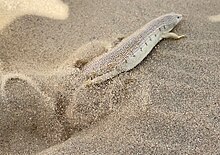| This article needs additional citations for verification. Please help improve this article by adding citations to reliable sources. Unsourced material may be challenged and removed. Find sources: "Eastern skink" – news · newspapers · books · scholar · JSTOR (April 2016) (Learn how and when to remove this message) |
| Eastern skink | |
|---|---|

| |
| Emerging from the sand, Al Wakrah, Qatar | |
| Conservation status | |
 Least Concern (IUCN 3.1) | |
| Scientific classification | |
| Domain: | Eukaryota |
| Kingdom: | Animalia |
| Phylum: | Chordata |
| Class: | Reptilia |
| Order: | Squamata |
| Family: | Scincidae |
| Genus: | Scincus |
| Species: | S. mitranus |
| Binomial name | |
| Scincus mitranus Anderson, 1871 | |
The eastern skink (Scincus mitranus), also known as the Arabian sand skink or the eastern sandfish, is a species of lizard in the skink family, Scincidae. It is endemic to the deserts and arid lands of the east-southeastern Arabian Peninsula north to Western Iran. Truly at home within fine, loosely-grained desert sand, this skink is known for resting while completely buried, keeping only its nostrils, and possibly part of its face, above ground for oxygen. In addition to ambushing passing invertebrate prey (likewise with only its nose or face exposed), Scincus mitranus will readily "dive" into the sand at the first sign of danger, appearing to "swim" through the dunes as they hastily bury themselves deeper to hide. Their naturally glossy, shiny and smooth scales—typical of the skink family, in general—enable quick digging and rapid movement within the fine, often very hot, substrate, with no external injury or irritation to their bodies. This behavior has earned S. mitranus its common names of "sandfish" and "sand skink".
Etymology
The specific name mitranus is after Indian archaeologist-anthropologist Babu Rajendralal Mitra (1824–1891).
Description
S. mitranus may grow to a length of 20 cm (7.9 in) and have an orange-brown or sand-coloured back, and a white underside. On the side it has a line or spots in a light colour, and the back and legs have vague dark bands. The snout is shaped like a bill, and the legs and tail are short.
Behaviour
The eastern skink can run quickly, or slide over the sand and dig itself in quickly when it is in danger.
Diet
S. mitranus preys on several kinds of arthropods, especially centipedes and beetles.
Geographic range and habitat
S. mitranus is found in the southern, eastern and northern areas of the Arabian Peninsula (Kuwait, Oman, Qatar, Saudi Arabia, Bahrain and the United Arab Emirates), Western Iran (near Ahvaz) and potentially east into Pakistan, though its actual presence in the country is disputed. In Oman, it has been sighted as far south and west as the region of Al-Mazyunah, Dhofar, close to the border with Yemen. In Saudi Arabia, it has been documented as far west as Riyadh and the deserts to the east of Al-Artawiyah and Umm Al Jamajm, north of the capital city.
Habitat
S. mitranus is associated with loose sand dune (aeolian) habitats.
Reproduction
The eastern skink is ovoviviparous, which gives it an advantage compared to other species in the area, as its eggs cannot desiccate.
References
- ^ Els, J.; Eid, E.K.A.; Al Johany, A.M.H.; Amr, Z.S.S.; Egan, D.M.; Sharifi, M.; Papenfuss, T.; Shafiei Bafti, S. (2012). "Scincus mitranus". IUCN Red List of Threatened Species. 2012: e.T164651A1064287. doi:10.2305/IUCN.UK.2012.RLTS.T164651A1064287.en. Retrieved 20 November 2021.
- ^ Scincus mitranus at the Reptarium.cz Reptile Database. Accessed 4 August 2016.
- Beolens, Bo; Watkins, Michael; Grayson, Michael (2011). The Eponym Dictionary of Reptiles. Baltimore: Johns Hopkins University Press. xiii + 296 pp. ISBN 978-1-4214-0135-5. (Scincus mitranus, p. 180).
- "Observations • iNaturalist". Retrieved 3 May 2024.
- "Observations • iNaturalist". Retrieved 3 May 2024.
Further reading
- Anderson J (1871). "Description of a New Species of Scincus ". Proc. Asiatic Soc. Bengal 1871: 115–116. (Scincus mitranus, new species).
- Boulenger GA (1887). Catalogue of the Lizards in the British Museum (Natural History). Second Edition. Volume III. ... Scincidæ ... London: Trustees of the British Museum (Natural History). (Taylor and Francis, printers). xii + 575 pp. + Plates I-XL. (Scincus mitranus, p. 393).
| Taxon identifiers | |
|---|---|
| Scincus mitranus | |